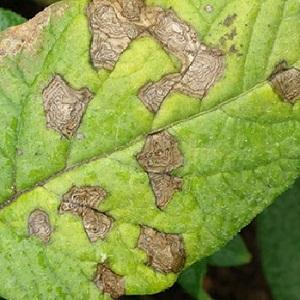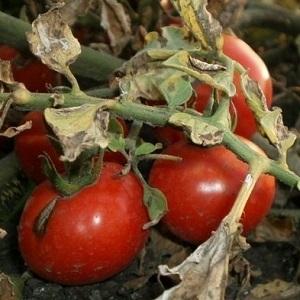What macrosporiosis of tomatoes looks like and why summer residents are so afraid of it: get to know the enemy better and defeat
Macrosporiasis of tomatoes causes crop loss for many summer residents. This disease can affect a plant at any stage of development, starting from seedlings. To keep the plantings healthy and get a rich harvest, you need to learn to recognize the pathogenic process at the initial stage. Read the description of tomato macrosporiosis, photos with signs of the disease, methods of prevention and control.
What is this disease and how does it affect tomatoes?
Macrosporiosis (dry spot) is a fungal infection of tomatoes. The disease usually develops on plants weakened due to lack of nutrients.
Macrosporiasis affects the stems, leaves and fruits of tomatoes. The disease can completely destroy plants and crops within two weeks. Fungal spores contaminate the soil, threatening the well-being of subsequent plantings.

Symptoms and external signs
At the initial stage, signs of damage are noticeable on the lower leaves: round, dry brown spots appear with clear outlines and a characteristic concentric pattern. Gradually, the fungus spreads to the stems and upper leaves.
Infected stems have brown and slightly depressed elongated spots. Then comes the turn of fruits. The lesion begins from the stalk or crack and spreads to the entire tomato in the form of dark brown, round, depressed spots. The structure of the fruit changes, it is no longer suitable for consumption.
Soon the disease covers the entire bush, individual spots of the lesion merge, the leaves dry out and die en masse. As the fungus develops, it begins to sporulate. The spots acquire a velvety black coating.
Causes of appearance and infection
The cause of the disease is the penetration of microspores of a pathogenic fungus into plant cells. This occurs due to mechanical damage to the stems and leaves. The immunity of tomatoes, weakened by pests and lack of necessary nutrition, does not resist the spread of infection. The development of macrosporiosis is facilitated by hot and humid weather.
The causative agent of the disease
The causative agent-pathogen is a fungus of the imperfect class Macrosporium solani Ellis. The best conditions for its germination are the presence of moisture in the form of drops and a temperature of 18-20ºС. The incubation period depends on temperature. At 22-24°C it is 2-3 days, at elevated (30-32°C) or low (14-16°C) temperatures it increases to 7-12 days.
The spores of the pathogen overwinter in the soil and on plant debris and remain viable for more than three years.
Terms of distribution
The causative agent of macrosporiosis spreads with the help of wind and raindrops. Infection of tomato tissue occurs through leaf stomata and places of mechanical damage.
The disease develops especially quickly in hot weather with heavy rain or dew. An increase in air temperature to 20-22°C and humidity to 80-90% always precedes the appearance of dry spotting on tomatoes.
How and with what to treat
Despite its seriousness, macrosporiasis is treatable. Experienced gardeners have many effective recipes in their arsenal.
Chemicals
At the first signs of dry spotting, you should immediately spray the tomato bushes with one of the following products:
 0.4% solution of copper oxychloride (oxychloride): 40 g of the drug per 10 liters of water. To increase the adhesion of the solution to the leaves, it is recommended to add a little 1% milk. Solution consumption – no more than 1 liter per 10 m2.
0.4% solution of copper oxychloride (oxychloride): 40 g of the drug per 10 liters of water. To increase the adhesion of the solution to the leaves, it is recommended to add a little 1% milk. Solution consumption – no more than 1 liter per 10 m2.- 1% Bordeaux mixture: Dissolve 100 g of copper sulfate and 100-150 g of slaked lime separately in 1 liter of hot water, bring each solution to 5 liters, strain the lime suspension and add the copper sulfate solution. Consumption – 1.5-2 liters per 10 m2.
- 0.4% zineb solution: Dilute 40 g of powder in 0.5 liters of water, mix thoroughly, bring the volume to 10 liters. The consumption of the working solution is about 1 liter per 10 m2.
Complex fungicidal agents are also suitable for processing tomatoes: “Polichom”, “Polycarbacin”, “Ridomil”. They should be used according to the instructions.
When working with all chemicals, you must follow safety requirements: use gloves and respirators, wash your hands and wash your clothes after finishing work.
Spraying with chemicals is carried out 3-4 times per season.
Important! The use of fungicidal preparations should be stopped no later than three weeks before harvest.
Traditional methods
For those who prefer natural remedies, there are traditional ways to combat macrosporiasis:
- Infusion of garlic and hot pepper. Grind 200 g of garlic in a blender or meat grinder, add 3 liters of water and leave in a dark place for two days. Strain the infusion, add 0.5 teaspoon of ground bitter red pepper. Spray the tomatoes with the resulting extract once every ten days.
- Iodine solution. Dissolve 20 drops of iodine in 8 liters of water; to improve the retention of the solution on the foliage, add a little dishwashing detergent. Spray tomatoes once a week when signs of fungal infection appear.
- Mullein infusion. Place 1 kg of rotted hay and 3 kg of fresh cow manure in a container. Pour 10 liters of water. Insist for three days. Then strain the infusion and treat plants with signs of disease 1-2 times a week.
Agrotechnical techniques
If macrosporiosis has significantly affected tomato bushes, you can try to save the crop. To do this, you need to remove the unaffected fruits and put them to ripen, after dipping them in hot (60 ° C) water and drying them.
Preventive measures
Prevention of any disease is easier than treatment. The following set of measures will help prevent dry spotting:
 Seed dressing - processing of planting material for the purpose of disinfection. The most accessible substance is potassium permanganate (potassium permanganate). To prepare a 1% solution, 1 g of the drug should be dissolved in 100 ml of water. Seeds Soak the tomatoes in the resulting liquid for 45 minutes, then rinse well with clean water.
Seed dressing - processing of planting material for the purpose of disinfection. The most accessible substance is potassium permanganate (potassium permanganate). To prepare a 1% solution, 1 g of the drug should be dissolved in 100 ml of water. Seeds Soak the tomatoes in the resulting liquid for 45 minutes, then rinse well with clean water.- Top dressing plants with microelements and pest control that weaken the protective functions of tomatoes.
- Alternation of plantings in such a way that tomatoes are planted in the same area no earlier than two years later.
- Location of beds with tomatoes at the maximum possible distance from other crops susceptible to macrosporiosis, such as potatoes.
- Autumn soil disinfection Bordeaux mixture or copper sulfate.
- Ensuring good ventilation to avoid high humidity when growing tomatoes in a greenhouse.
- Regular treatment of instruments with disinfectants or boiling water.
- Burning of plant residues after harvesting.
Advice from gardeners
Dry spot affects tomatoes at any stage of growth.Therefore, throughout the growing season they need attention and care. To maintain their own protective functions, plants need watering, loosening the soil and fertilizing.
Even after successfully treating tomatoes for macrosporiosis, the soil in the greenhouse should be replaced. In the infected bed, after harvesting the tomato tops, sow mustard in early autumn.
If possible, it is better to give preference varietiesresistant to this disease.
Conclusion
Macrosporiasis is a serious fungal infection of tomatoes that can destroy the entire crop in a matter of days. The causative agent is a fungus that is spread by the wind, affects all parts of the plant, and loves a warm and humid environment. Able to remain viable in soil for three years.
The disease is fought with fungicides: traditional Bordeaux mixture, copper oxychloride and others. There are also a number of traditional safe methods. The main preventive measure is maintaining the health and natural immunity of tomatoes. Treating seeds and reasonable crop rotation will help avoid contamination of the site.